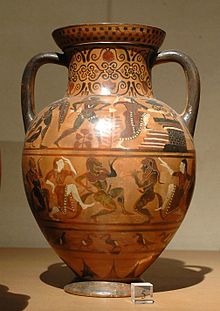Pontic vases
As Pontic Group , a sub-style is Etruscan - black-figure vase painting of the second half of the 6th century BC. Chr. Designated. About 200 vases of this group are known today.

Ferdinand Dümmler's vases were given the misleading name “Pontic” due to the depiction of archers on a vase that was thought to be Scythians who lived on the Black Sea ( Pontos Euxeinos ).
However, due to their location and style, the Pontic vases have been recognized as Etruscan. Most of the vases were found in tombs in Vulci , and another considerable part in Cerveteri . The style is based on Attic black-figure vase painting, but also has influences from Corinthian and Eastern Greek vase painting . It is sometimes believed that the vases were made in workshops in Etruria by craftsmen who immigrated from Ionia . To date, research has identified five main vase painters. The Paris painter is considered the earliest and best , followed by the Tityos painter .
The main form is the neck amphora , which is remarkably slim. They are very similar to Tyrrhenian amphorae . Other forms were oinochoai with spiral handles, Dinoi , Kyathos , plates and cups hochfußige, rare kantharos or others. The structure of Pontic vases is the same. In general, they have an ornamental decoration on the neck, a figurative frieze followed on the shoulder, followed by another ornamental band, which was followed by an animal frieze and finally a halo. The base, neck and handle are black. The importance of the ornaments is striking. Sometimes vessels are decorated purely ornamentally.

The tone of the vases is yellowish-red, the glossy tone with which the vases were coated black to brownish-reddish, is of high quality and has a metallic sheen. Red and white opaque paint are used a lot for figures as well as ornaments. Animals were usually decorated with a white stripe on their stomach. The ornaments are often designed rather carelessly. Shown are mythological characters like a beardless Hermes , Centaurs , Theseus , the Minotaur , Achilles and Troilus , satyrs , maenads , and how eastern Greece in common a beardless Herakles . There are also representations from the Trojan saga . Sometimes there are scenes outside of Greek mythology, such as Heracles fighting Iuno Sospita by the Paris painter or a wolf demon by the Tityos painter. Outside the mythological themes there are comasts and riders.
literature
- Pericle Ducati : Pontic vases. (= Research on ancient ceramics . Row 1: Pictures of Greek vases. Vol. 5). Keller, Berlin 1932.
- Tobias Dohrn : The black-figure Etruscan vases from the second half of the sixth century. Triltsch & Huther, Berlin 1936, pp. 33–89, 145–151 (Cologne, University, dissertation, 1935).
- John D. Beazley : Etruscan vase painting (= Oxford Monographs on Classical Archeology. Vol. 1, ZDB -ID 417418-5 ). Clarendon Press, Oxford 1947, p. 12.
- Enrico Paribeni : Pontici, Vasi. In: Ranuccio Bianchi Bandinelli (ed.): Enciclopedia dell'Arte Antica. Volume 6: Pec - Saq. Istituto della Enciclopedia Italiana, Rome 1965, digitized .
- Maria Antonietta Rizzo: La ceramica a figure nere. In: Marina Martelli (ed.): La ceramica degli Etruschi. La Pittura Vascolare. Istituto Geografico de Agostini, Novara 1987, pp. 31-35.
- John Boardman : Early Greek Vase Painting. 11th - 6th centuries BC. A handbook. Thames and Hudson, London 1998, ISBN 0-500-20309-1 , pp. 219-223.
- Matthias Steinhart : Pontic vase painting. In: The New Pauly (DNP). Volume 10, Metzler, Stuttgart 2001, ISBN 3-476-01480-0 , column 138 f.
- Thomas Mannack : Greek vase painting. An introduction. Theiss, Stuttgart 2002, ISBN 3-8062-1743-2 , p. 133.
Individual evidence
- ^ Ferdinand Dümmler: About a class of Greek vases with black figures. In: Communications from the Imperial German Archaeological Institute, Roman Department. Vol. 2, 1887, ISSN 0342-1287 , pp. 171-192, digitized .